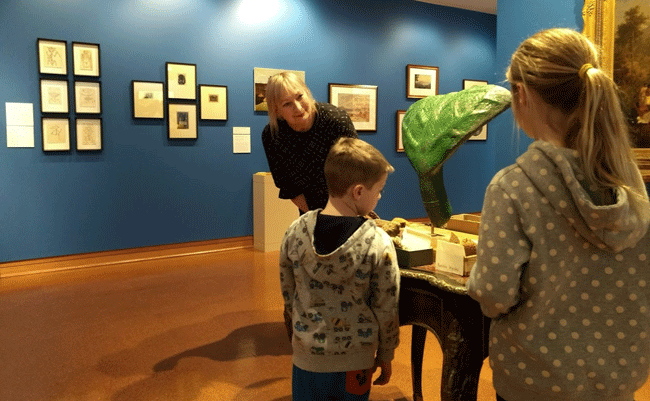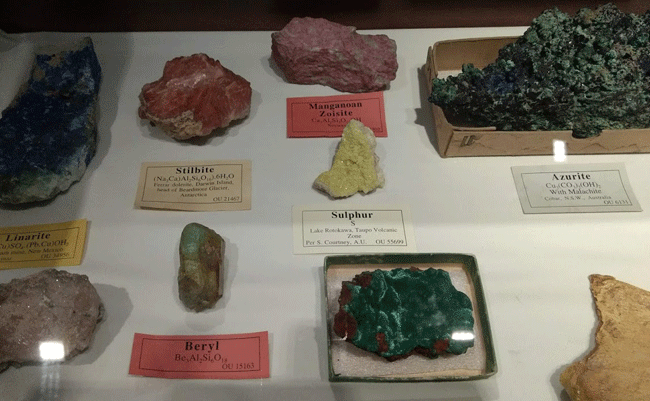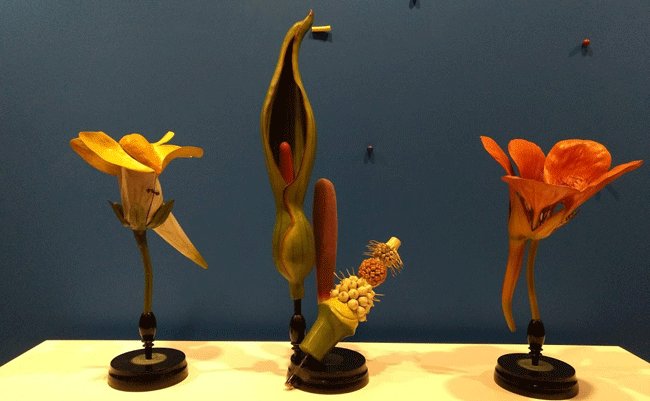Tuesday 30 July 2019 10:04pm
A Garden of Earthly Delights is the Hocken’s contribution to the University’s 150th anniversary.
This special exhibition, featuring beautiful and diverse objects and works of art gathered from the museums and collections around the University, opened in May and will have its last day on Sunday 11 August.
Otago Bulletin Board Editor Lisa Dick visited recently, and urges others to take a look before it closes in just under a fortnight.

Curator Robyn Notman (left) shows us around A Garden of Earthly Delights at the Hocken.
It is with slight trepidation that I take two of my children to explore A Garden of Earthly Delights at the Hocken. It’s not that I don’t think they’ll enjoy it: I’ve been assured that this colourful and original exhibition has been extremely popular with families. I’m worried about their noise, their busy fingers, their spinning bodies. The curators - the Hocken’s Head Curator of Pictorial Collections Robyn Notman and 2008 Frances Hodgkins Fellow and artist Heather Straka - have spent several months visiting the University’s various museums and collections, selecting precious items, and thinking about how to meaningfully display them. I really don’t want to be responsible for snaps, dents or hand prints.
I remind them not to touch anything. “Can we touch the floor with our feet?” they ask facetiously. “Can we touch each other?”
I needn’t have worried. Ms Notman meets us at the exhibition, and shows us around. Discreet cards on the tables remind people not to touch, and the whole exhibition is so bright and interesting no one gets tempted to spin.
“We wanted it to feel almost like going into a diorama or a painting,” she says, her enthusiasm rubbing off on even my more reluctant child, “like you are walking among all the things you can see. We wanted to activate the senses, and stimulate the imagination. We also wanted people to make links between the different items on show.”
She takes us through a room with bright blue walls, and we examine sparkling crystals in a cabinet.
“We’ve borrowed these from the Geology Museum,” she explains. “I visited three or four times, looking and thinking before selecting them. I mainly chose them because of their colours and the way they catch your eye and sparkle. But I love the places they come from too. It’s almost like you’re being taken on a world journey.”
Bright blue Linarite from New Mexico sits alongside pale pink Stilbite from Antarctica, pink Manganoan Zoisite from Norway and sparkly green Azurite from Australia.

Eye-catching crystals from around the world, sourced from the University's Geology Museum, are a highlight.
The room beside us, painted deep emerald green, is equally intriguing. An array of objects displayed in cases, paintings and diagrams on the walls. At first glance it looks like an eclectic mix, but Ms Notman points out some of the strategic links and the exhibition immediately becomes far more interesting: a poster from Botany featuring a mushroom variety called a wood ear has been positioned near a large papier mâché model of a human ear from the W. D. Trotter Anatomy Museum (said to be one of just eight left in the world and by a famous model maker Dr Louis Auzoux in the 1850s), while on a nearby wall there is a drawing by Colin McCahon titled Hear me O South Wind, no 1 , 1977 from Hocken Collections which calls us directly to listen.
In another cabinet a moa’s foot bones from the Archaeology Programme collections have been placed beside silcrete blades excavated from Shag Mouth which would have been used by Māori to cut up moa meat.
While the objects are fascinating, so too are some of the tables and cabinets used to display them. Some have been borrowed from outside the University, including cases from the Dunedin Public Art Gallery and Toitu; some are from inside the University, including a study table from Geology covered in deeply carved student initials from the past.
“This is actually a working table,” Ms Notman says. “Geology usually use other side, but we turned it over to show the graffiti. The department really treasures it, and they only loaned it on the promise that we give it back.”

Some of the many 19th Century Brendel plant models from the Department of Botany which feature in the exhibition.
“Where did the idea for the exhibition come from?” I ask as we look at intricate 19th Century Brendel plant models borrowed from Botany.
“Well, as a starting point we wanted to create something memorable for the University’s 150th,” she says. “We wanted to bring together a selection of some of the most amazing things from the special collections from the University. Some of these objects are readily accessible, and some are not. We wanted people to be able to learn what’s here, and feel inspired.”
It’s clearly working.
While the visitor numbers haven’t yet been tallied, the counter on the door indicates it has been the Hocken’s most popular exhibition in some time – bringing in perhaps twice as many people as usual.
It’s also attracting a wider and more diverse group, Ms Notman says. Like me, people are bringing their children; some are visiting more than once.
It has been so successful, she says she will be sad when 11 August rolls around and the objects and artworks are packaged up and carefully returned to their various homes around the Dunedin campus.
“What legacy would you like this exhibition to have?” I ask. “What do you hope people remember?”
“I hope it stays in people’s memories and imaginations as a wonderful experience and is inspiring,” she says. “I hope it encourages children to be curious about coming to university and studying art, geology and botany. I hope it helps people realise that the University has rich and diverse collections that are both treasured and still used.”
A hand tugging at my arm, and a very quiet whinging tells me I’ve spent too much time talking. It’s time to go. But I would love to stay longer. Or come back for a second look. I feel Ms Notman’s sadness that this amazing exhibition will soon be over.
It has been a successful and fascinating visit. And we didn’t break anything.
Check it out:
A Garden of Earthly Delights
Hocken Collections, Uare Taoka o Hākena, 90 Anzac Ave, Dunedin
Until Sun 11 Aug, 2019
(The exhibition is open Mon to Sat, 10am to 5pm. On the final day, Sunday 11 August, the exhibition is open 2pm to 5pm)The exhibition has also been recently highlighted in the ‘Down in Edin’ magazine